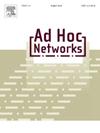无线传感器网络中节点定位的锚节点选择与放置策略
IF 4.4
3区 计算机科学
Q1 COMPUTER SCIENCE, INFORMATION SYSTEMS
引用次数: 0
摘要
无线传感器网络中锚节点的位置对定位精度影响很大。本文导出了刚性旋转平移变换下的cram本文章由计算机程序翻译,如有差异,请以英文原文为准。
Anchor nodes selection and placement strategy for node positioning in wireless sensor networks
The positions of anchor nodes in wireless sensor networks (WSNs) significantly impacts positioning accuracy. This paper derives the Cramér–Rao lower bound (CRLB) under rigid roto-translation transformations and demonstrates that a larger equilateral triangle formed by anchor nodes minimizes positioning errors. Based on this theoretical insight, a graph theory and geometry-based anchor node selection (ANS) method is proposed. The method is further extended to solve the anchor node placement (ANP) problem, and the particle swarm optimization (PSO) is employed to determine optimal placement positions. Simulation results confirm that the proposed ANS and ANP methods outperform existing approaches in positioning accuracy.
求助全文
通过发布文献求助,成功后即可免费获取论文全文。
去求助
来源期刊

Ad Hoc Networks
工程技术-电信学
CiteScore
10.20
自引率
4.20%
发文量
131
审稿时长
4.8 months
期刊介绍:
The Ad Hoc Networks is an international and archival journal providing a publication vehicle for complete coverage of all topics of interest to those involved in ad hoc and sensor networking areas. The Ad Hoc Networks considers original, high quality and unpublished contributions addressing all aspects of ad hoc and sensor networks. Specific areas of interest include, but are not limited to:
Mobile and Wireless Ad Hoc Networks
Sensor Networks
Wireless Local and Personal Area Networks
Home Networks
Ad Hoc Networks of Autonomous Intelligent Systems
Novel Architectures for Ad Hoc and Sensor Networks
Self-organizing Network Architectures and Protocols
Transport Layer Protocols
Routing protocols (unicast, multicast, geocast, etc.)
Media Access Control Techniques
Error Control Schemes
Power-Aware, Low-Power and Energy-Efficient Designs
Synchronization and Scheduling Issues
Mobility Management
Mobility-Tolerant Communication Protocols
Location Tracking and Location-based Services
Resource and Information Management
Security and Fault-Tolerance Issues
Hardware and Software Platforms, Systems, and Testbeds
Experimental and Prototype Results
Quality-of-Service Issues
Cross-Layer Interactions
Scalability Issues
Performance Analysis and Simulation of Protocols.
 求助内容:
求助内容: 应助结果提醒方式:
应助结果提醒方式:


